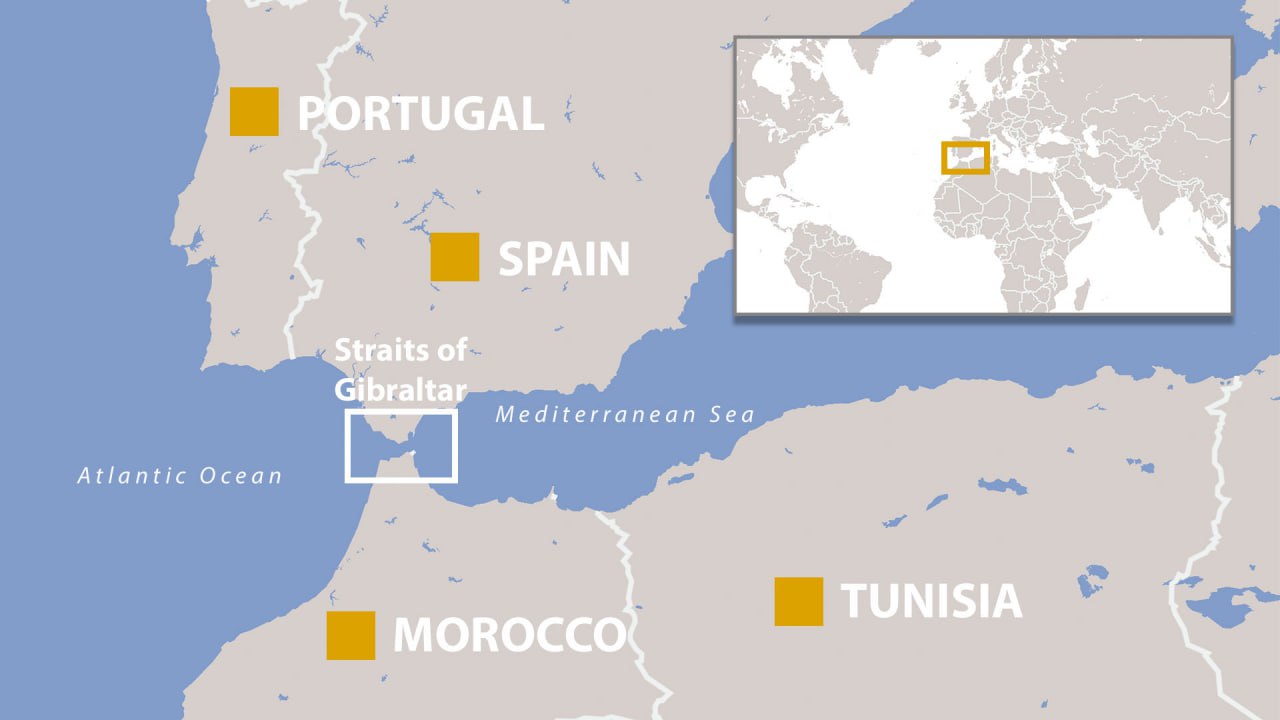The Strait of Gibraltar is a strategic waterway that separates the continents of Europe and Africa and connects the Mediterranean Sea to the Atlantic Ocean. Due to its historical and geopolitical significance, it has become a critical point for global maritime traffic and military strategies. Gibraltar is not only important for maritime traffic but has also become a symbol in the sovereignty struggles of the countries in the region.

Strait of Gibralta
Geographical Location of the Strait of Gibraltar
The Strait of Gibraltar is located at the southern tip of Europe, between the Gibraltar Peninsula in Spain and the northeastern part of Tangier in Morocco. It is 60 km long and 44 km wide. The narrowest point of the Strait, between the Cape of Gibraltar and Ceuta, is approximately 13 km wide. This Strait is the only natural waterway connecting the Mediterranean Sea to the Atlantic Ocean, making it of great importance in global maritime traffic.
The rocky formations and underwater features on either side of the Strait present significant navigational challenges. There is a strong current flowing from east to west, while weaker currents are observed as they flow from the Mediterranean to the Atlantic Ocean. Gibraltar, with its high rocky structures and strategic position, has attracted the attention of many civilizations throughout history.
History of the Strait of Gibraltar
In ancient times, Gibraltar was known as "Calpe." This region has attracted the attention of many civilizations and has been an important maritime point. The history of Gibraltar began with the Phoenicians and Romans, later followed by Arabs, Christians, and Ottomans, who all fought for control over the area.
The Tarik Bin Ziyad Era (711)
Gibraltar played a significant role in the spread of Islam to the West when, in 711, the Arab commander Tarik bin Ziyad crossed into Andalusia. Tarik bin Ziyad, coming from North Africa, crossed the Strait of Gibraltar to reach the Iberian Peninsula. This event marked the beginning of the Islamic conquests, and the Strait was named "Jabal al-Tariq" (Tarik's Mountain) after him. Over time, this name was adapted into European languages as Gibraltar. Gibraltar is also known as "Jabal al-Fath" (Mountain of Victory).
Muwahhid Period and Establishments in Andalusia (12th Century)
Before the Muwahhid rulers entered Andalusia, Gibraltar was primarily used as a harbor for ships. Between 1159 and 1160, the Muwahhid ruler Abd al-Mu’min ordered the construction of a large city at the foot of Gibraltar, which included infrastructure such as mosques, palaces, barracks, and a water distribution network. This marked an important military and cultural turning point in the history of Gibraltar.
Spanish Rule and English Intervention (16th Century)
In 1309, Gibraltar was incorporated into the Kingdom of Castile by Alonso Pérez de Guzmán. However, in 1333, the Merinids recaptured Gibraltar, and it was besieged again in 1340 by King Alfonso XI of Castile. During the 15th century, Gibraltar remained under the control of the Nasrids, and in 1502, it was incorporated into the Kingdom of Spain by Queen Isabella.
The English Conquest (1704)
Gibraltar was captured by English and Dutch naval forces in 1704. In the Treaty of Utrecht in 1713, Spain ceded Gibraltar to England. This treaty solidified England’s sovereignty over Gibraltar. During this period, Gibraltar became a military base and an important hub for maritime traffic.
Strategic Importance of the Strait of Gibraltar
The Strait of Gibraltar is not only geographically important but also plays a critical role in military and economic terms. This waterway, which connects the Mediterranean Sea to the Atlantic Ocean, is an important link in global maritime traffic.

Strait of Gibraltar, Traffic and Geolocation Image (Source: VesselFinder)
Military Strategy
Historically, Gibraltar has been a critical point for states seeking military dominance. The rivalry between Spain and England highlights the military importance of the region. In the 18th century, Spain attempted to reclaim Gibraltar, but the Great Siege from 1779 to 1783 was unsuccessful. England's victory in this siege allowed it to use Gibraltar as a military base.
Global Trade Routes
The Strait of Gibraltar is one of the busiest maritime routes in the world. Approximately 7,500 ships pass through the Strait annually. This passage ensures the continuity of energy and trade routes between Europe and Africa. Additionally, after the opening of the Suez Canal, the Strait of Gibraltar remained a key route for Western Europe’s access to Asia.
Economic Importance of the Strait of Gibraltar
Historically, Gibraltar has been an important center not only militarily but also commercially. Trade and maritime activities are intense on both sides of the Strait.
Port Services and Passage Fees
Gibraltar provides fuel refueling and other maritime services to large ships. The port is one of the largest refueling hubs in the world. Ships passing through the Strait are charged passage fees, contributing to the local economy.


